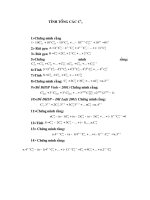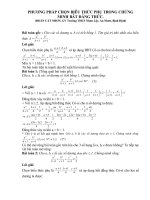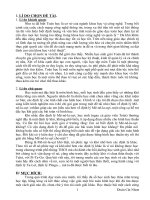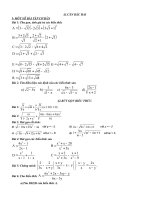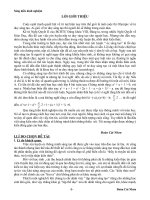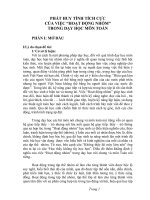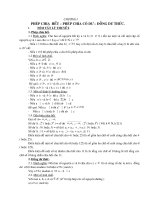21 c n bond forming reactions
Bạn đang xem bản rút gọn của tài liệu. Xem và tải ngay bản đầy đủ của tài liệu tại đây (1.49 MB, 15 trang )
Myers
Chem 115
C!N Bond-Forming Reactions: Reductive Amination
Reviews:
Reducing Agents
Abel-Magid, A. F.; Mehrman, S. J. Org. Proc. Res. Devel. 2006, 10, 971–1031.
Abdel-Magid, A. F.; Carson, K. G.; Harris, B. D.; Maryanoff, C. A.; Shah, R. D. J. Org. Chem. 1996,
• Common reducing agents: NaCNBH3, Na(OAc)3BH, H2/catalyst
61, 3849-3862.
Bhattacharyya, S. Tetrahedron Lett. 1994, 35, 2401–2404.
Hutchins, R. O.; Hutchins, M. K., Reduction of CdN to CHNH by Metal Hydrides. In Comprehensive
Organic Synthesis; Trost, B. N., Fleming, I., Eds.; Pergamon Press: New York, 1991; Vol. 8.
Overview:
• Iminium ions are reduced selectively in the presence of their carbonyl precursors. Reagents
such as sodium cyanoborohydride and sodium triacetoxyborohydride react selectively with
iminium ions and are frequently used for reductive aminations.
Reduction with Sodium Cyanoborohydride:
• The reductive amination of aldehydes and ketones is an important method for the synthesis of
primary, secondary, and tertiary amines.
• Reductive amination is a powerful and reliable strategy for the formation of C–N bonds, and
can avoid the problem of overalkylation that often accompanies direct alkylation of amines
with alkyl halides.
• Borch and co-workers showed that sodium cyanoborohydride and lithium cyanoborohydride
are acid-stable reagents capable of rapidly reducing carbonyl compounds to alcohols at pH
3–4, presumably via a protonated carbonyl cation.
• Reductive amination involves a one- or two-step procedure in which an amine and a carbonyl
compound condense to afford an imine or iminium ion that is reduced in situ or subsequently
to form an amine product.
R3
O
R1
+
R2
NaBH3CN
CH3OH
O
Mechanism:
R3
N
H
R4
R1
N
HO
R4
Ph
CH3
pH 3, 23 °C, 1 h
93%
OH
Ph
CH3
(±)
Borch, R. F.; Bernstein, M. D.; Durst, H. D. J. Am. Chem. Soc. 1971, 93, 2897–2904.
H+ (cat.)
R2
R3
R4
hydride
R2
source
N
R1
R3
R1
N
H
R4
R2
• At pH 7, reduction of carbonyl compounds with lithium cyanoborohydride is very slow, even
at reflux in methanol.
R1, R2, R3, R4 = H, alkyl, aryl
!H2O
R4 = H
R3
R1
hydride,
N
R2
proton source
Ph
• relative rates of reductive amination:
LiBH3CN
CH3OH
O
CH3
pH 7, reflux, 72 h
36%
OH
Ph
CH3
(±)
H
N
H2NR
>
>
n
n = 1, 2
HNR2
> H2NAr
Borch, R. F.; Durst, H. D. J. Am. Chem. Soc. 1969, 91, 3996–3997.
Jonathan William Medley, Fan Liu
1
C!N Bond-Forming Reactions: Reductive Amination
Myers
Chem 115
• With care to maintain a pH of 6–7, a mixture of a ketone or aldehyde reactant, an amine, and
sodium cyanohydride provides products of reductive amination selectively, without
competitive reduction of the carbonyl substrate.
Reduction with Sodium Triacetoxyborohydride:
• Though the conditions of the Borch reduction are mild, sodium cyanoborohydride is highly
toxic, as are its byproducts.
• This protocol is generally high yielding, highly functional group tolerant, and proceeds without
release of cyanide salts. The substrate scope includes aromatic and aliphatic aldehydes,
ketones, and primary and secondary amines. Ammonia can be employed successfully if used
in large excess as its acetate salt.
O
R1
+
R2
R3
N
H
R4
carbonyl compound
amine
O
O
NaBH3CN
CH3OH
pH
6–8,a
R3
R1
23 °C
N
H
• Sodium triacetoxyborohydride has been found to be a highly selective reducing agent for
reductive amination; acetic acid is frequently employed as a proton donor.
R4
O
R2
R1
isolated yield (%)
product
+
R3
N
H
R2
carbonyl compound
H3C
CH3NH2
H3C
CH3
H
EtO
cycloheptanone
OH
H2NOH
N
66
yield (%)
96
N
NH2
H
N
II
EtO
88
OEt
NH4OAc
(10 equiv)
IIb
cycloheptylamine
CH3
N
CH3
96
I
O
80c
NHPh
NHPh
O
H3C
PhNH2
H
78
H
OHC
CH3
CH3
N
NH2
O
OH
HO
O
product
Ph
PhNH2
H3C
R2
90
Ph
N
H
R4
N
OEt
CH3
O
R1
N
N
H
NHCH3
Ph
Method
II
79
O
O
R3
Ph
N
O
N
H
NaHB(OAc)3
methoda
amine
O
N
R4
O
NH3
HO
OH
O
O
II
95
N
N
N(i-Pr)2
H
(±)
Borch, R. F.; Bernstein, M. D.; Durst, H. D. J. Am. Chem. Soc. 1971, 93, 2897–2904.
COOEt
O
51
aThe pH was maintained by addition of HCl and/or KOH as needed using bromocresol green as an
indicator.
COOEt
H
N
(i-Pr)2NH
II
88
aMethod
I: ClCH2CH2Cl, AcOH (1!2 equiv), NaBH(OAc)3 (1.3!1.6 equiv). Method II: ClCH2CH2Cl,
NaBH(OAc)3 (1.3!1.6 equiv). bEt3N (1.5!2.0 equiv) added. cyield of HCl salt.
Jonathan William Medley
2
Myers
Chem 115
C!N Bond-Forming Reactions: Reductive Amination
Reaction with Weakly Nucleophilic Amines:
O
R1
+
R3
R2
carbonyl compound
N
H
R4
Reduction with Sodium Borohydride:
NaHB(OAc)3
R3
Method
R1
methoda
amine
• Reductive amination of carbonyl compounds with primary amines can be complicated by
overalkylation. In these cases, formation and isolation of the imine followed by reduction can prove
to be a superior alternative.
R4
N
R2
H
• It was found that the use of methanol as solvent allows for rapid (< 3h) and nearly quantitative imine
formation from aldehydes without the need for dehydrating reagents.
product
yield (%)
O
Br
O
Br
III
H
N
89b
R1
+
R3 NH2
CH3OH
!H2O
R2
R3
NaBH4
N
R1
R2
10!15 min
R3
R1
N
H
R4
R2
H2N
aldehyde
Cl
O
Cl
Cl
H
IV
amine
O
Cl
H3CO
N
yield (%)a
product
H
N
H
PhNH2
Cl
95
Ph
84
H2N
O
H
O
N
IV
H2N
Cl
Cl
H
H
NO2
95
Ph
H
PhNH2
N
H
H
t-BuNH2
N
H
Ph
90
S
IV
N
H
89
Bn
O
60
N
N
t-Bu
83
H
O
Ph
H
S
H2N
N
H
O
NO2
O
H2N
H2N Ts
H
IVc
N Ts
80
Bn
H
Ph
BnNH2
Ph
NHBn
85
O
aMethod
III: ClCH2CH2Cl, AcOH (1 equiv), NaBH(OAc)3 (1.4 equiv). Method IV: ClCH2CH2Cl,
AcOH (2!5 equiv), carbonyl compound (1.5!2 equiv), NaBH(OAc)3 (2.0!2.8 equiv). byield of HCl
salt. cEt3N (2.0 equiv) added.
aproducts
isolated as HCl salts.
Abdel-Magid, A. F.; Carson, K. G.; Harris, B. D.; Maryanoff, C. A.; Shah, R. D. J. Org. Chem.
1996, 61, 3849!3862.
Jonathan William Medley
3
C!N Bond-Forming Reactions: Reductive Amination
Myers
Chem 115
Examples in Synthesis
O
CH3
OTBS
AcO
CH3
H3C
Na(AcO)3BH, Sn(OTf)2
+
CHO
N
H H
O
H3C
4 Å MS, ClCH2CH2Cl, 0 °C
HO
H
O
CH3O
66%
O
CH3
HO
O
CH3
O
OCH2
OCH3
Et
O
O
N(CH3)2
O
CH3
NaBH3CN
O
OH
OH
CH3
OH
CH3
CH3OH,
NH
tylosin
AcO
79%
OTBS
CH3
N
H3C
CH3 N
Hosokawa, S.; Sekiguchi, K.; Hayase, K.; Hirukawa, Y.; Kobayashi, S. Tetrahedron Lett. 2000,
41, 6435-6439.
H3C
HO
CH3O
O
O
NaBH3CN
H
N
H CH3
CH2O
O
O
H O
Ph Ph
O
Ph Ph
H
N
H3C CH3
CH3
O
OCH2
OCH3
Et
HO
O
CH3
O
O
N(CH3)2
O
CH3
O
O
OH
OH
CH3
OH
CH3
Matsubara, H.; Inokoshi, J.; Nakagawa, A.; Tanaka, H.; Omura, S. J. Antibiot. 1983, 36, 1713-1721.
84%
Jacobsen, E. J.; Levin, J.; Overman, L. E. J. Am. Chem. Soc. 1988, 110, 4329-4336.
H CO2Bn H CO2Bn
OHC
• Formic acid can also be used as a hydride donor:
H3C
HO
H3C
H3C
H
N
OH
H3C
O
CH3
OH
CH3
HO
O
CH3
O
H3C
HO
H3C
N(CH3)2
O
OCH3
CH3
OH
CH3
CH3
H3C
CH2O, HCO2H
N
OH
H3C
O
CH3
H
OH
CH3
HO
O
O
O
CHCl3, 65 ºC
71%
OTHP
+
H3C
O
O
N
CO2t-Bu
CH3
O
NaBH3CN
H
CO2Bn
N
CO2t-Bu
N
CH3OH
H CO2Bn H CO2Bn
OTHP
59%
1. H2, Pd/C, EtOH,
H2O, HCl
2. TFA
CO2Bn
NH•TFA
N(CH3)2
O
CH3
OCH3
CH3
OH
CH3
H
CO2H
H CO2H H CO2H
N
H
N
OH
2'-deoxymugineic acid
Ohfune, Y.; Tomita, M.; Nomoto, K. J. Am. Chem. Soc. 1981, 103, 2409-2410.
Dokic, S.; Kobrehel, G.; Lopotar, N.; Kamenar, B.; Nagl, A.; Mrvos, D. J. Chem. Res (S). 1988, 152.
Mark G. Charest, Fan Liu
4
Myers
Chem 115
C!N Bond-Forming Reactions: Reductive Amination
• A regioselective reductive amination using sodium triacetoxyborohydride was employed in
the construction of the pyrrolidine ring of (!)-communesin A:
H3C CH3
O
N
H3C
H3C O
O
H3C CH3
O
HN
N
H3C
H3C O
OH
NH4OAc
NaHB(OAc)3
CH3OH, >92%
NH
• In a complex transformation, a tryptamine derivative and an enantioenriched dialdehyde
were combined to give a cyclic bis-hemiaminal interemediate; electrophilic activation with
trifluoroacetic anhydride initiated a Mannich/Sakurai cascade. Subsequent iminium reduction
with sodium cyanoborohydride afforded a pentacyclic diamine en route to (!)-aspidophytine.
OH
NH
N
CH3
NH2
N
CH3
H3CO
O
CH3
N
N
OCH3 CH3
N
CH3CN
OHC
4 steps
H3C
OHC
H3CO
R
TMS
R = CH2COOi-Pr
HO
N
OCH3 CH3
R
TMS
TFAA (2 equiv)
!TFA
Ac
N
CF3COO
NH
N
CF3COO
R TMS
N
!CF3COOTMS
N
CH3
H3CO
(!)-communesin A
N
OCH3 CH3
H3CO
N
OCH3 CH3
R
TMS
Zuo, Z.; Ma, D. Angew. Chem., Int. Ed. 2011, 50,12008!12011.
• Regio- and stereoselective indolenine reduction and reductive methylation of two secondary
amines was achieved using Borch conditions en route to (+)-haplophytine.
O
N
N
H
N
O
N
CO2CH3
TFA
HCHO, NaBH3CN
AcOH
MsO
H3CO
CH2Cl2, CH3OH
0 " 23 °C
55%
N
O
CH3 OCH3
O
N
CH3
N
O
N
N H
OCH3 CH3
H3CO
O
N
O
N O
HO
N H
O
CH3 OCH3 CH3
R
NaBH3CN
(5 equiv)
66%
N H
OCH3 CH3
CO2CH3
O
MsO
CH3
N
O
N
CF3COO
R
N O
N H
O
CH3 OCH3 CH3
1. 1N NaOH, CH3OH, 60 °C.
2. K3Fe(CN)6, NaHCO3,
t-BuOH, H2O, 70% (2 steps).
N
6 steps
H3CO
N H
OCH3 CH3
R
N H
OCH3 CH3
H3CO
(!)-aspidophytine
(+)-haplophytine
Ueda, H.; Satoh, H.; Matsumoto, K.; Sugimoto, K.; Fukuyama, T.; Tokuyama, H. Angew. Chem.,
Int. Ed. 2009, 48, 7600!7603.
He, F.; Bo, Y.; Altom, J.; Corey, E. J. J. Am. Chem. Soc. 1999, 121, 6771!6772.
Jonathan William Medley
5
Myers
Chem 115
C–N Bond-Forming Reaction: The Buchwald-Hartwig Reaction
Reviews:
Solvent Choices:
• Most general: toluene, THF, DME, dioxane, and tertiary alcohols
• Water is compatible but rates of reaction are often slower.
• DMF, NMP, MeCN, acetone, etc., should be avoided as single solvents, but they can be great cosolvents, especially for substrates containining potentially chelating functional groups that
otherwise might inhibit catalysis.
Surry, D. S.; Buchwald, S. L. Chem. Sci. 2011, 2, 27–50.
Klinkenberg, J. L.; Hartwig, J. F. Angew. Chem. Int. Ed. 2011, 50, 86–95.
Industrial Review of C-N and C-O Coupling:
Schlummer, B.; Scholz, U. Adv. Synth. Catal. 2004, 346, 1599–1626.
Activation
• The Buchwald-Hartwig reaction is the coupling of an amine with an aryl halide mediated by a
palladium catalyst.
R
R'
NH
+
X Ar
PdLn
R'
Base, Solvent
R
• In order for the catalytic cycle to begin, palladium must be in the Pd(0) oxidation state. One of the
most common Pd(0) sources is Pd2dba3.
• Pd(II) sources can be used and are more stable, but they require reduction to Pd(0). One of most
common activation methods is via reduction of Pd(OAc)2 with PR3, water, and heat.
N Ar
Pd(II)(OAc)2 + 2PR3
Mechanism:
(R3P)Pd(0)(OAc) + AcOPR3
Pd(0)PR3
H2O
O=PR3 + 2HOAc
Activation
LnPd(0) or LnPd(II)
R
Reductive
Elimination
N
Ar
R'
Oxidative
Addition
Ar X
Ozawa, F.; Kubo, A.; Hayashi, T. Chem. Lett. 1992, 11, 2177–2180
Amatore, C.; Carre, E.; Jutand, A.; M'Barki, M. Organometallics 1995, 14, 1818–1826
Fors, B. P.; Krattiger, P.; Strieter, E.; Buchwald, S. L. Org. Lett. 2008, 10, 3505–3508.
LnPd(0)
• Precatalyst systems allow for lower reaction temperatures.
LnPd(II)(Ar)[N(R)R']
LnPd(II)(Ar)(X) Coordination
R
Base-HX
Deprotonation
Base
H
R'
R
N
N
H
NaOtBu
R'
Pd
Cl
NH2
dioxane, 23 ºC
L–Pd(0)
(active catalyst)
+
L
N
H
LnPd(II)(Ar)(X)
Biscoe, M. R.; Fors, B. P.; Buchwald, S. L. J. Am. Chem. Soc. 2008, 130, 6686-6687.
The Base (bolded bases are the most commonly used):
• For fast reactions: strong bases such as NaOt-Bu, KOH (uncrushed pellets)
• For substrates bearing sensitive functional groups: weaker bases such as K3PO4, Cs2CO3,
K2CO3 with t-BuOH or t-amyl alcohol
• For substrates bearing acidic functional groups, use of LiHMDS as base affords lithiates that can
prevent catalyst inhibition.
K3PO4
Pd
Cl
NH2
THF, 23 ºC
L–Pd(0)
(active catalyst)
+
N
H
L
Kinzel, T.; Zhang, Y.; Buchwald, S. L. J. Am. Chem. Soc. 2010, 132, 14073–14075.
Harris, M. C.; Huang, X.; Buchwald, S. L. Org. Lett. 2002, 4, 2885–2888.
Rob Singer, David Bernhardson
6
Myers
Chem 115
C–N Bond-Forming Reaction: The Buchwald-Hartwig Reaction
Oxidative Addition
Coordination
• Electron-rich and sterically hindered aryl halides undergo slower oxidative addition. Reactivity
order: I > Br > OTf > Cl > OTs.
• Electron-rich amines are superior substrates due to their enhanced nucleophilicities.
Deprotonation
• Binding to Pd increases the acidity of the amine, which facilitates deprotonation.
I
R
H2N R
Cl
R=
H2N
90%
Cl
Pd2(dba)3, Xantphos
NaOt-Bu, toluene
80 ºC
Br
Reductive Elimination
NH
H2N
Br
96%
Br
• Electron deficient amines undergo slower reductive elimination.
• Bulky ligands help to accelerate reductive elimination through steric repulsion.
Ph Ph
P
Ph
Pd
Fe
N R1
P
R2
Ph Ph
Amine
R1
Ph N
R2
Temp
1.5 h
pKa (HNR2)
Temp (ºC)
Yield (%)
N(tolyl)2
25
85
90
NHPh
30
25
80
NHi-Bu
41
0
64
Larsen, S. B.; Bang-Andersen, B.; Johansen, T. N.; Jorgensen, M. Tetrahedron, 2008, 64, 2938–2950.
Hartwig, J. F. Inorg. Chem. 2007, 46, 1936–1947.
Examples of Ligands
Boc
N
Ph2P
PPh2
Buchwald
OCH3
O
Boc
N
N
H
Br
N
Pd2(dba)3, Xantphos
N
Cl
NaOt-Bu, toluene
100 ºC, 96%
H3C CH3
N
PCy2
Oi-Pr
i-PrO
Cl
addition.
Boc
N
N
H
Fe
OCH3
H3CO
i-Pr
NaOt-Bu, toluene
100 ºC, 95%
N
Br
Ji, J.; Li, T.; Bunnelle, W. H. Org. Lett. 2003, 5, 4611–4614.
Maes, B. U. W.; Loones, K. T. J.; Jonckers, T. H. M.; Lemiere, G. L. F.; Dommisse, R. A.; Haemers, A.
Synlett, 2002, 1995–1998.
Josiphos
CyPFtBu
Ph
Pd
Q-phos
O
P(t-Bu)2
i-Pr
i-Pr
NH
Cl
L
Pre-Ru: L = RuPhos
Pre-Brett: L = BrettPhos
i-Pr
N
N
Ph
P(Ad)2
JackiePhos
P(t-Bu)2
Ph
Singer
N
i-Pr
N
Fe
Ph
Stradiotto
3,5-CF3C6H4
P 3,5-CF3C6H4
i-Pr
Br
Br
Ph
Ph
BrettPhos
(for 1º amines)
RuPhos
(for 2º amines)
readily, and tend to form bridged palladium dimers.
• Halides in the 2- and 4-positions of 6-membered hetercycles are predisposed towards oxidative
N
P(t-Bu)2
PCy2
i-Pr
• Iodides are less frequently used because they tend to be more expensive, dehalogenate more
Pd2(dba)3, Xantphos
CH3
PCy2
i-Pr
Xantphos
• OTf and OTs may undergo competing hydrolysis.
Boc
N
H3CO
i-Pr
Hartwig
Mor-DalPhos
Ph N N
P(t-Bu)2
Ph
Bippyphos
tBuXPhos
Rob Singer, David Bernhardson
7
Myers
Chem 115
C–N Bond-Forming Reaction: The Buchwald-Hartwig Reaction
Nitrogen nucleophiles
Secondary Amines vs. Primary Amines
• Listed, in decreasing order, by approximate ease of coupling: anilines, secondary amines, primary
amines, amides, sulfamides, five-membered heterocycles (i.e. pyrazole, imidazole, etc.), and ammonia.
• Ligand choice is important. A catalyst that is too hindered inhibits reactions with secondary
amines, while primary amines require a hindered ligand, to avoid double arylation.
Anilines
OR
OR
N
N
Br
N
N
O
N
H
O
Ar
CH3
ArNH2, K3PO4, DME, 80oC
N
H
Pd2(dba)3, BINAP
CH3
N
N
N
N
O
O
N
H
O
O
N
N
H
CH3
Br
CH3
61-81%
OTBS OTBS
OTBS OTBS
R = CH2Ph or 4-CN-PhCH2CH2
Meier, C.; Sonja, G. Sylett 2002, 802–804.
• A selective C–N coupling reaction was used in the synthesis of the core of variolins, a group of marine
natural products with potent cytotoxic activities against murine leukemia cells:
H2N
Cl
Br
N
Cl
Br
N
Cl
N
Pd(OAc)2 (5 mol%)
JohnPhos (10 mol%)
NaOt-Bu (1.4eq)
THF, 70 ºC, 83%
N
PdL (1 mol%)
NaOt-Bu, dioxane
100 ºC
H3CO
H3CO
CH3
n = 2 or 4
H
N
PdL (1 mol%)
NaOt-Bu, dioxane H CO
3
100 ºC
n
CH3
n = 2 or 4
PdL
Pre-Ru - 30% (GC), n = 7
Pre-Brett - 99% (GC), n = 7
Pd(dba)2/Qphos - 85% (isolated), n = 5
PdL
Pre-Ru - 99% (GC)
Pre-Brett - 17% (GC)
Pd(dba)2/Qphos - 96% (isolated)
Fors, B.; Buchwald, S. L. J. Am. Chem. Soc., 2010, 132, 15914–15917.
Kataoka, N.; Shelby, Q.; Stambuli, J. P.; Hartwig, J. F. J. Org. Chem. 2002, 67, 5553–5566.
(1.2 eq)
N
H2N
N
HN
N
• The combination of Pd(OAc)2 and CyPFt-Bu is highly effective for monoarylation of primary
amines. While it can be used to effect arylation of secondary amines, the rate is slower and
higher catalyst loading is required:
N
O
O
P(t-Bu)2
N
Johnphos
N
69% (isolated)
• The selectivity in this case is attributed to the directing effects of the neighboring nitrogen atoms.
N
H
Pd(OAc)2 (1 mol%)
CyPFt-Bu (1 mol%)
NaOt-Bu, DME, 90 ºC
Cl
N
n-C8H17 NH2
Pd(OAc)2 (0.005 mol%)
CyPFt-Bu (0.005 mol%)
NaOtBu, DME, 90 ºC
n-C8H17
N
H
N
100% (GC)
92% (isolated)
A. Baeza, C. Burgos, J. Alvarez-Builla, J. J. Vaquero, Tetrahedron Lett. 2007, 48, 2597
Shen, Q.; Ogata, T.; Hartwig, J. F. J. Am. Chem. Soc. 2008, 130, 6586–6596.
Rob Singer, David Bernhardson
8
Myers
Amides as Substrates
Challenging Substrate for Coupling
CH3
• Aminopyridines frequently function as chelating ligands with palladium. This effect can be mitigated
by the use of LiHMDS and hindered, reactive ligands.
O
Cl
HN
H2N
O
N
H
N
H
N
Br
PdL (2 mol%)
LiHMDS, 65 ºC
NH2
N
Chem 115
C–N Bond-Forming Reaction: The Buchwald-Hartwig Reaction
N
PdL (4 mol%)
LiHMDS, 65 ºC
NH2
PdL
Pre-Ru - 79% (isolated)
Pre-Brett - <10% (GC)
N
CH3
[Pd(allyl)Cl]2 (1 mol%)
JackiePhos (5 mol%)
Cs2CO3, 3Å MS
O
t-Bu
N
O
t-Bu
toluene, 130 ºC, 81%
NH2
Hicks, J. D.; Hyde, A. M.; Cuezva, A. M.; Buchwald, S. L. J. Am. Chem. Soc., 2009, 131, 16720–
16734.
PdL
Pre-Ru - 47% (GC)
Pre-Brett - 78% (isolated)
• Application to the synthesis of an HIV-1 integrase inhibitor:
Perez, F.; Minatti, A. Org. Lett. 2011, 13, 1984–1987.
Selective Coupling of Primary over Secondary Amines
N N
H3CO
N
OH
O
1. Pd(OAc)2, Xantphos
N
Ph NH
Cl
Pre-Brett (1 mol%)
BrettPhos (1 mol%)
NaOt-Bu, dioxane
80 ºC, 89%
HN Ph
NH
NH
NH2
N
H
Br
H2N
1% Pre-Brett
1% BrettPhos
NaOt-Bu, dioxane
80 ºC, 84%
NH
H
N
O
N
Cs2CO3, dioxane, 65 ºC
2. TMSCl, NaI
MeCN, 92%
F
N N
N
N
O
F
O
Fors, B. P.; Watson, D. A.; Biscoe, M. R.; Buchwald, S. L. J. Am. Chem. Soc., 2008, 130, 13552–
13554.
Johns, B. A.; Weatherhead, J. G.; Allen, S. H.; Thompson, J. B.; Garvey, E. P.; Foster, S. A.; Jeffrey,
J. L.; Miller, W. H. Bioorg. Med. Chem. Lett., 2009, 19, 1807–1810.
Large-Scale Amination
Ureas as Substrates
• Application to the synthesis of a CNS-Active aminotetralin:
• Application to the synthesis of a TRPV1 receptor antagonist:
CH3
CH3
H
N
CH3
Br
N
H
Ph
Pd(OAc)2 (0.5 mol%)
BINAP (2 mol%)
+
N
CH3
NaOt-Bu, toluene
100 ºC
"quantitative yield"
125-kg scale
N N
CH3
N
N
H
O
Ph
N
CH3
Federsel, H.-J.; Hedberg, M.; Qvarnström, F. R.; Tian, W. Org. Process Res. Dev. 2008, 12, 512–521.
Federsel, H.-J.; Hedberg, M.; Qvarnström, F. R.; Sjögren, M. P. T.; Tian, W. Acc. Chem. Res. 2007,
40, 1377–1384.
HN
F3C
NH2
t-Bu
N N
Cl
CH3
O
Pd2(dba)3 (1 mol%)
Bippyphos (2 mol%)
K3PO4, DME
80 ºC, 84%
CH3
HN
F3C
N
H
t-Bu
Yu, S.; Haight, A.; Kotecki, B.; Wang, L.; Lukin, K.; Hill, D. R. J. Org. Chem., 2009, 74, 9539–9542.
Rob Singer, David Bernhardson
9
Myers
Chem 115
C–N Bond-Forming Reaction: The Buchwald-Hartwig Reaction
• Application to the synthesis of an intermediate en route to a tetracycline antibiotic:
Sulfamides as Substrates
• Application to the synthesis of a c-Met Kinase Inhibitor:
H2N
O
O
Br
Pd2(dba)3 (6.6 mol%)
Xantphos (15 mol%)
N
Cs2CO3, THF
60 ºC, 69%
(3.4 kg)
H
N
O
Cl
CH3 O
N
S
O O
N
CH3
N
O
Br
CO2Ph
OBn
O
NH2
t-BuO
Br
S
O O (2.88 kg)
O
Cl
CH3 O
N
NH
t-BuO
Pd2(dba)3 (5 mol%)
Xantphos (15 mol%)
N
Cs2CO3, dioxane
80 ºC, 62%
Br
Carbamates as Substrates
CO2Ph
N
H
t-BuO
4
CH3
N
O
OBn
(9.6 kg)
Stewart, G. W.; Brands, K. M. J.; Brewer, S. E.; Cowden, C. J.; Davies, A. J.; Edwards, J. S.;
Gibson, A. W.; Hamilton, S. E.; Katz, J. D.; Keen, S. P.; Mullens, P. R.; Scott, J. P.; Wallance, D. J.;
Wise, C. S. Org. Process Res. Dev, 2010, 14, 849–858
Br
CH3
:
CO2Ph
OBn
1
Clark, R. B.; He, M.; Fyfe, C.; Lofland, D.; O'Brien, W. J.; Plamondon, L.; Sutcliffe, J. A.; Xiao, X.-Y. J.
Med. Chem., 2011, 54, 15-11-1528
N-Heterocyles as Substrates
H3C
Br
H2N
t-Bu
O
Ot-Bu
Pd2(dba)3•CHCl3 (3 mol%)
t-BuXPhos (9 mol%)
NaOt-Bu, toluene
23 ºC, 76%
H
N
O
Ot-Bu
t-Bu
Bhagwanth, S.; Waterson, A. G.; Adjabeng, G. M.; Hornberger, K. R. J. Org. Chem., 2009, 74, 4634–
4637.
Pd2(dba)3 (1.5 mol%)
t-BuBrettPhos (3.6 mol%)
Br
N
O
NaOCN
H
N
tBuOH*, 130 ºC, 73%
N
O
t-Bu
t-Bu
N
N
Cl
H3C
N
H
N
NH2
HCl
dioxane, 70%
N
N
H
NH
N
N
Pd2(dba)3 (0.5 mol%)
Xantphos (1.5 mol%)
Na2CO3, dioxane
70 ºC, 73%
H3C
O
Ot-Bu
N
NH2
N
N
N
*Other alcohols can be used to make other carbamates
Shen, Z.; Hong, Y.; He, X.; Mo, W.; Hu, B.; Sun, N.; Hu, X. Org. Lett. 2010, 12, 552–555.
Perez, F.; Minatti, A. Org. Lett. 2013, 15, 1394–1397.
Rob Singer, David Bernhardson
10
Myers
Chem 115
C–N Bond-Forming Reaction: The Buchwald-Hartwig Reaction
Ammonia as a substrate
• Application to the synthesis of Vitamin E Amines:
NH2
1.
[Pd(cinnamyl)Cl2]2 (1.5 mol%)
Mor-DalPhos (2.25 mol%)
Cl
N
NaOt-Bu, NH3, 1,4-dioxane
110 ºC, 79%
NH2
Pd(OAc)2, BINAP
NaOt-Bu, toluene, 80 ºC
N
2.
Pd/C, HCO2NH4
MeOH, 65 ºC
67% (2 steps)
CH3
F3C
Cl
NaOt-Bu, NH3, 1,4-dioxane
110 ºC, 69%
t-Bu
O
[Pd(cinnamyl)Cl2]2 (3.0 mol%)
Mor-DalPhos (4.5 mol%)
NH2
S
CH3
O
O
H3C
O
CH3
H2N
R
CH3
1.
H3C
CH3
t-Bu
2.
CH3
Ammonia Surrogates
R=
CH3
HCl, H2O, THF
23 ºC, 79% (2 steps)
CH3
CH3
• Application to the synthesis of a JAK2 Inhibitor:
H3CO
N
N
Cl
Mazzini, F.; Netscher, T.; Salvadori, P. Eur. J. Org. Chem. 2009, 2063–2068.
1.
OCH3
NH
O
Ot-Bu
N
N
CH3
Pd2(dba)3, Xantphos
Cs2CO3, dioxane, 90oC
H3CO
O
N
N
2. HCl, water, THF, 2 min
23 ºC, 89%
PCT Int. Appl., 2011028864, 10 Mar 2011.
R
CH3
NH
Pd(OAc)2, BINAP, NaOt-Bu
toluene, 80 ºC
Lundgren, R. J.; Peters, B. D.; Alsabeh, P. G.; Stradiotto, M. Angew. Chem. Int. Ed., 2010, 49, 4071–
4074.
OCH3
O
H2N
CH3
CH3
Ot-Bu
S
N
N
CH3
N
N
N
Br
S
NH
Pd2(dba)3 (0.25 mol%)
BINAP (0.75 mol%)
NaOCH3, toluene, 83–87 ºC;
37% HCl, 70–78 ºC;
5N NaOH, 55–65 ºC
N
NH2
14-kg scale, 86%
Liu, Y.; Prashad, M.; Repic, O.; Blacklock, T. J. J. Heterocyclic Chem. 2003, 40, 713–716.
Rob Singer, David Bernhardson
11
Myers
Chem 115
C–N Bond-Forming Reaction: Cu-Catalyzed, Ullmann-Type Couplings
Typical Ligands:
Reviews:
1,2-diamines (most common), amino acids, 1,3-dicarbonyls, 1,2-amino alcohols, 1,2-diols
Surry, D. S.; Buchwald, S. L. Chem. Sci. 2010, 1, 13–31.
Monnier, F.; Taillefer, M. Angew. Chem. Int. Ed. 2009, 48, 6954–6971.
Ma, D.; Cai, Q. Acc. Chem. Res. 2008, 41, 1450–1460.
Ley, S. V.; Thomas, A. W. Angew. Chem. Int. Ed. 2003, 42, 5400–5449.
• Examples
H3C
N
A comparison between Pd- and Cu-catalyzed C–N Bond-Forming Processes:
Beletskaya, I. P.; Cheprakov, A. V. Organometallics 2012, 31, 7753–7808.
N
O
Overview
R
R'
NH
+
X Ar
R'
Base, Solvent
R
OH
N
NH
O
O
CH3
H3C NH HN CH3
Cu salt
O
O
N
CH3 OH
OH
O
OEt
N
O
CH3
N Ar
O
OH
• The Ullman-type reaction involves coupling amines and other nitrogen nucleophiles with an aryl
halide, catalyzed by copper salts.
N
H3C NH HN CH3
• Copper is highly effective for coupling aryl halides with amides, carbamates, azoles and ureas.
These substrates tend to be problematic in Pd-catalyzed couplings.
• The mechanism may follow the same cycle as with Pd, but is more likely to involve coordination of
the amine prior to oxidative addition (Strieter, E. R.; Blackmond, D. G.; Buchwald, S. L. J. Am.
Chem. Soc. 2005, 127, 4120–4121).
OH
N
N
N
OH
N
N O
H
O
• 1,2-Diamines are among the most general supporting ligands in Cu-Catalyzed C-N Couplings: The
amine nucleophiles often coordinate to copper to form a stable bis-amine complex which impedes
catalysis. Diamine chelation suppresses this undesired pathway.
Critical Features of Ligand Design:
Mechanism:
R
Reductive
Elimination
N
Ar
Ethylene or cyclohexane
backbone is most
effective.
R'
R
LnCu(I)X
LnCu(III)X(Ar)[N(R)R']
N
H
R'
Coordination
R = CH3 gives highest
reaction rate; larger
groups impede rate.
R NH HN R
Further substitution to
give tertiary amine, such
as TMEDA, leads to
ineffective ligands.
LnCu(I)X[NH(R)R']
R = H leads to ligand arylation.
Typical Cu salts:
LnCu(I)
Oxidative Addition
Ar X
R
N
R'
Base
Base-HX
CuI (most common), CuBr, CuOAc, Cu2O.
Deprotonation
Typical Solvents:
NMP, DMAC, DMSO, DMF, toluene, THF, DME, dioxane.
Typical Bases:
• an alternative mechanism involves oxidative addition prior to coordination.
Most general: Cs2CO3. Commonly used: K2CO3, K3PO4.
May be used: KOH, CsF, CsOAc.
Rob Singer, David Bernhardson
12
Myers
Preparation of benzimidazoles:
R
Et
NH
I
• Lactams couple selectively over secondary amines:
H3C NH HN CH3
(20 mol%)
O
+
Chem 115
C–N Bond-Forming Reaction: Cu-Catalyzed, Ullmann-Type Couplings
R'
NH2
Et
NH
R
O
Et
N
R
+
Br
R'
R' 68–93%
N
H
CuI (5 mol%), Cs2CO3,
dioxane, 90 ºC
AcOH
H3C NH HN CH3
Bn
NH
HN
O
(10 mol%)
Bn
CuI (5 mol%), K2CO3,
toluene, 110 ºC, 78%
N
N
NH
O
Klapars, A.; Parris, S.; Anderson, K. W.; Buchwald, S. L. J. Am. Chem. Soc. 2004, 126, 3529–
3533.
Zheng, N.; Buchwald, S. L. Org. Lett. 2007, 9, 4749–4751.
Selective coupling of pyridazinone in the presence of a sulfonamide and a secondary amide:
Application to the Synthesis of the Natural Product Geldanamycin
O
I
N
N
O
S
HN
O
O
NC
O
+
N
H
N
H3C NH HN CH3
(10 mol%)
NH
N
CuI (4 mol%)
K3PO4, DMF,
110 ºC
HN
NC
Oi-Pr
O
S
O
O
H3C NH HN CH3
Br
N
Oi-Pr
H3C
H
N
CH3
H3CO
CH3
O
O
Oi-Pr
H3CO
H3CO
(2 equiv)
H2N
OBn
CH3 OCH3
O
CH3
CuI (1 equiv)
N
CH3
Oi-Pr H
BnO H3CO
H3C
K2CO3, 110 oC,
toluene, 81%
O
H3CO
H3C
OMOM
CH3 CH3
OMOM
Schweinitz, A.; Dönnecke, D.; Ludwig, A.; Steinmetzer, P.; Schulze, A.; Kotthaus, J.; Wein, S.;
Clement, B.; Steinmetzer, T. Bioorg. Med. Chem. Lett. 2009, 19, 1960–1965.
4 steps
Preparation of quinolones:
O
H3CO
R
H3C NH HN CH3
O
(20 mol%)
CH3
Br
O
+
Ph
O
R
CH3
CuI (10 mol%)
NH2
K2CO3, toluene,
110 ºC
NH
O
Ph
NaOH
dioxane, 110 ºC
67–89%
R
O
N
H
H3C
O
N
H
CH3
O
HO H3CO
H3CO
Ph
O
O
NH2
CH3 CH3
Geldanamycin
Jones, C. P.; Anderson, K. W.; Buchwald, S. L. J. Org. Chem. 2007, 72, 7968–7973.
Qin, H.-Li.; Panek, J. S. Org. Lett. 2008, 10, 2477–2479.
Rob Singer, David Bernhardson
13
Myers
Couplings of Azoles
N
NH
+
Couplings of Primary Amines:
I
Br
Cu2O (5 mol%)
I (20 mol%)
Cs2CO3, MeCN
50 ºC, 89%
• Proline is one of few ligands that can facilitate Cu-catalyzed C–N coupling with anilines:
N
OH
N
Br
N
OH I
Br
NH
+
CuBr (10 mol%)
II (20 mol%)
I
Cs2CO3, DMSO
60 ºC, 85%
O
N
OEt
+
I
• Inexpensive amino acids can be used as ligands and demonstrate a broad substrate scope:
O
N
Bn
Bn
N
O
NH2
N
CuI (10 mol%)
L-proline (20 mol%)
H
N
N
N
K2CO3, DMSO
80 ºC, 77%
Br
O
N
N
Bn
N
H
Cl
N
NaOCH3, DMSO
110 ºC, 90%
N
Br
O
O
N
OH III
Ma, H.-C.; Jiang, X.-Z. J. Org. Chem. 2007, 72, 8943–8946.
N
NH
+
I
O2N
Cs2CO3, DMSO
60 ºC, 84%
N
N
O2N
Yang, K.; Qiu, Y. Q.; Li, Z.; Wang, Z.; Jiang, S. J. Org. Chem. 2011, 76, 3151–3159.
CH3
V
N
H
Ph
CuI (10 mol%)
DMPAO (20 mol%)
H3C
N
Ph
H3C
OH
NH
K3PO4, DMSO
90 ºC, 86%
OCH3
O
CH3
OCH3
DMPAO
• This methodology can also be applied to primary amines and cyclic secondary amines, but not to
anilines.
Zhang, Y.; Yang, X.; Tao, Q.; Ma, D. Org. Lett. 2012, 14, 3056–3059.
• Couplings catalyzed by Ligand IV proceed under mild conditions and with a low loading of the
copper catalyst:
CuBr (1 mol%)
IV (2 mol%)
CH3
Br
Cs2CO3, DMF
23 ºC, 98%
O
N
N
O
• Couplings of acyclic secondary amines was virtually unprecedented until the discovery of
DMPAO as a supporting ligand:
H3C
+
O
H N
Shafir, A.; Buchwald, S. L. J. Am. Chem. Soc. 2006, 128, 8742–8743.
O
• Ligand III is effective for heterocycles and even activated aryl chlorides:
CuI (10 mol%)
III (20 mol%)
CuI (5 mol%)
V (20 mol%)
Bn
Cai, Q.; Zhu, W.; Zhang, H.; Zhang, Y.; Ma, D. Synthesis 2005, 496–499.
Zhang, H.; Cai, Q.; Ma, D. J. Org. Chem. 2005, 70, 5164–5173.
N
OCH3
II
NH2
N
OCH3
K2CO3, DMSO
90 ºC, 97%
• Room-temperature C–N coupling can be achieved using ligand V:
Lv, X.; Bao, W. J. Org. Chem. 2007, 72, 3863–3867.
I
H
N
CuI (20 mol%)
L-proline (40 mol%)
Zhang, H.; Cai, Q.; Ma, D. J. Org. Chem. 2005, 70, 5164–5173.
O
N
OCH3
H2N
OCH3
Cristau, H.-J.; Cellier, P. P.; Spindler, J.-F.; Taillefer, M. Chem. Eur. J. 2004, 10, 5607–5622.
N
Chem 115
C–N Bond-Forming Reaction: Cu-Catalyzed, Ullmann-Type Couplings
• DMPAO can also be applied to the synthesis of aryl carbamates:
Br
N O
+ KOCN
OH
IV
Cl
H
N
CuI (20 mol%)
DMPAO (40 mol%)
n-BuOH, 110 ºC, 80%
On-Bu
O
Cl
Yang, X.; Zhang, Y.; Ma, D. Adv. Synth. Catal. 2012, 354, 2443–2446.
Rob Singer, David Bernhardson, Fan Liu
14
C–N Bond-Forming Reaction: Cu-Catalyzed, Ullmann-Type Couplings
Myers
Ligand-controlled N-Arylation versus O-arylation of amino alcohols
Chem 115
Heterocycle formation via tandem coupling and hydroamidation
NH2
1.
OH
H3C NH HN CH3
Br
H2N
CuI (5 mol%)
L2 (10 mol%) Br
O
I
+
CsCO3, PhCH3
90 ºC, 86%
CuI (5 mol%)
L1 (20 mol%)
CsCO3, DMF
23 ºC, 97%
HO
20:1
Br
NH
n-Pr
NH
N
>50:1
n-Pr
CH3
O
CH3
O
N
N
H3C
CH3
L2
CuI (5 mol%), Cs2CO3
THF, 80 ºC, 84%
N
+
OH
CH3
OH
CuI (2.5 mol%), K3PO4
Ph
H
N
ethylene glycol, i-PrOH
75 oC, 76%
B(OH)2
N
Et N
Ph
O
NH
Cu(OAc)2 (1.1 equiv)
+
B(OH)2
Et N
N
air, Et3N, CH2Cl2
4Å MS, 79%
Ph
CuI (5 mol%)
OH
CH3
N
CH2Cl2, 23 ºC
O2, 98%
O
OH
CH3
Ph
I + H3CHN
n-Pr
CuI (5 mol%), Cs2CO3
n-Pr THF, 80 ºC, 84%
[Cu(OH)•TMEDA]2Cl2
(10 mol%)
H3C
Protic solvent favors C-N coupling
Ph
N
n-Pr
2. TFA, CH2Cl2, 23 ºC
+
Ph
Boc
CH3
• Chemoselective N-Arylation of 1,2-amino alcohols: the substrate functions as the ligand. The
choice of solvent dictates C–N versus C–O bond formation.
H2N
(20 mol%)
NH2Boc
I
Cu-catalyzed C–N couplings with boronic acids
H
N
I
n-Pr
L1
Shafir, A.; Lichtor, P. A.; Buchwald, S. L. J. Am. Chem. Soc. 2007, 129, 3490–3491.
OH
H3C NH HN CH3
Martin, R.; Rivero, M. R.; Buchwald, S. L. Angew. Chem. Int. Ed. 2006, 45, 7079–7082.
CH3
H3C
(20 mol%)
H
Boc
N
N
Boc
H
Cs2CO3, n-butyronitrile
125 ºC, 74%
H3CHN
OPh
Cu(OAc)2 (10 mol%)
CH3
+
NH2
Aprotic solvent favors C-O coupling
B(OH)2
O2, CH2Cl2, 23 ºC
4Å MS, 85%
N
H
Job, G. E.; Buchwald, S. L. Org. Lett. 2002, 4, 3703–3706.
• C–N coupling can be facilitated by ortho-chelating groups:
CuI (5 mol%)
Cs2CO3, DMF, 23 ºC
O
OH
Br
OH
+ n-Hexylamine
96% yield
(0% yield in the absence of CuI)
H2N
O
N
H
Diao, X.; Xu, L.; Zhu, W.; Jiang, Y.; Wang, H.; Guo, Y.; Ma, D. Org. Lett. 2011, 13, 6422–6425.
CH3
CO2CH3
Ph
+
Cu(OAc)2 (10 mol%)
B(OH)2
O2, CH2Cl2, 23 ºC
4Å MS, 90%
(no epimerization observed)
N
H
CO2CH3
Ph
Lam, P. Y. S.; Vincent, G.; Clark, C. G.; Deudon, S.; Jadhav, P. K. Tetrahedron Lett. 2001, 42,
3415–3418.
Collman, J. P.; Zhong, M. Org. Lett. 2000, 2, 1233–1236.
Quach, T. D.; Batey, R. A. Org. Lett. 2003, 5, 4397–4400.
Rob Singer, David Bernhardson
15
